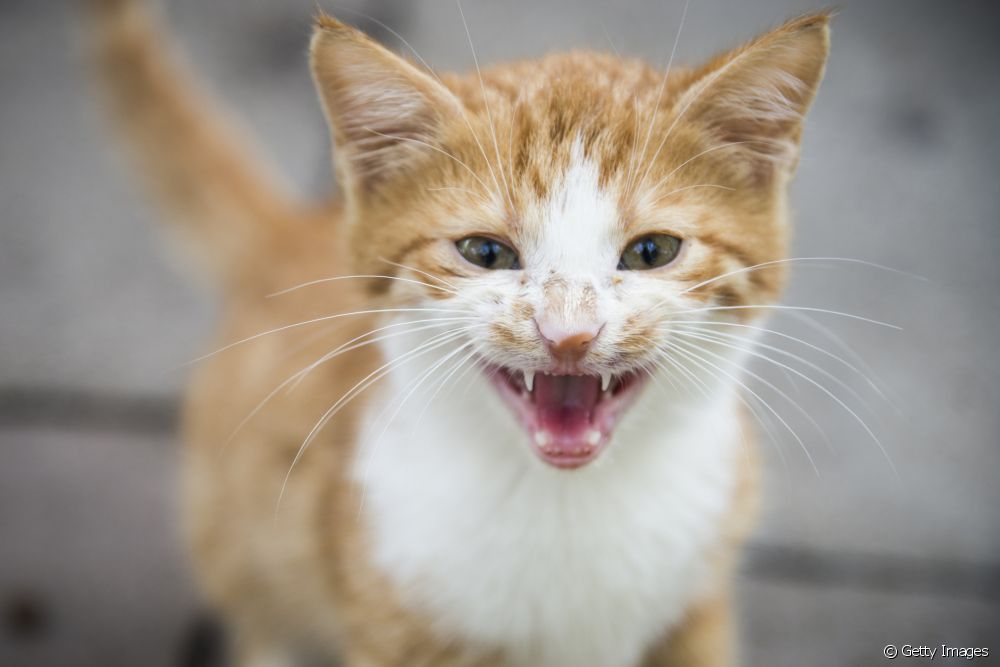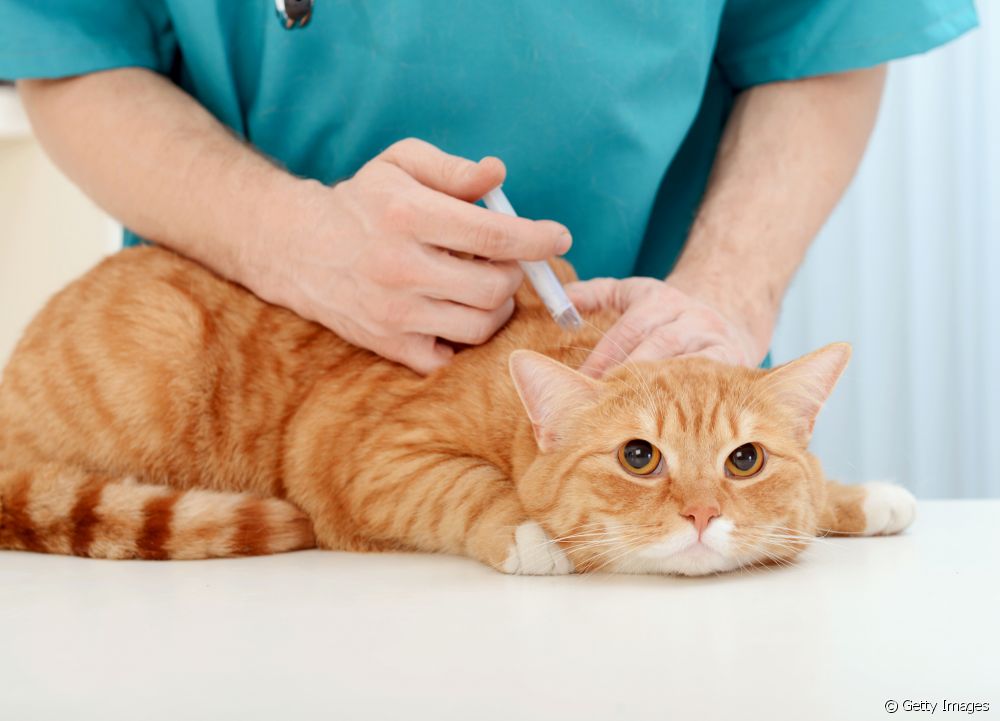Cat with rabies: learn all about the effects of the disease on felines

Table of contents
Everyone has probably heard about the dangers of canine rabies, right? But the truth is that dogs are not the only animals that can be hit by this terrible disease. Although it is a little more difficult to find a cat with rabies, feline lovers need to keep in mind that this is a problem that can also affect the health of the cat and that needs a lot of attention, especiallyas it is a highly contagious and lethal disease.
Yes, that's right: in the vast majority of cases, feline rabies ends up leading the animal to death and, therefore, it is essential to know how to prevent it and also how to identify a cat with rabies. To clarify the main doubts about rabies in cats (symptoms, diagnosis and prevention), we interviewed veterinarian Izadora Sousa, from Rio de Janeiro. See what she told us!
Is rabies in cats similar to canine rabies after all?
When we talk about rabies, it is common that the first image that appears in our head is that of a rabid dog, since the incidence of this disease in dogs is much higher than in cats. However, felines are not immune to this disease and also have a high chance of catching feline rabies, especially when it comes to an animal that is not up to date with vaccinations and that has the habit of ...move around the streets frequently.
But is there any difference between these diseases, besides their transmitters, after all? Well, as the veterinarian explains, feline and canine rabies manifest themselves in very similar ways: both cause a series of damages to the central nervous system of infected animals, which start to show aggressiveness and can develop a series of other symptoms. "This is considered one of thezoonoses of greatest concern, as their lethality rate is almost 100%", emphasizes Izadora.
Rabies: cats become infected through contact with the saliva of an infected animal.
The contagion of feline rabies occurs basically in the same way as canine rabies: "Rabies is transmitted mainly by inoculation of the infected animal's saliva into the victim, especially through pre-existing bites or scratches/wounds that come into direct contact with the animal's saliva".
For this reason, kittens who have an active life outside the home are more likely to be infected with the disease, especially if they have not been properly vaccinated. There is no way of knowing who the kitten may meet on the street and, therefore, the risk of contact with infected animals is great. As aggressiveness is one of the main symptoms of the disease, cat fights end up being a gateway to the disease.for this disease, since bites and scratches are inevitable at these times.
What's more, it's a mistake to think that only cats and dogs can contract rabies. In fact, all mammals are vulnerable when it comes to this disease, including humans. Therefore, there's no such thing as too much care when it comes to feline rabies, to spare both your pet kitten and your own health.

Feline rabies: symptoms of the disease can vary
First of all, it is necessary to understand that the symptoms of feline rabies do not always manifest themselves in a unique way. That is, they can vary greatly in each case. However, as this is a disease that affects the central nervous system quite significantly, one of the main ways to tell if your pet has been contaminated or not is by observing if there are changes in the cat's behavior,especially if he has recently run away from home. More affectionate and friendly cats, for example, can end up becoming more aggressive overnight, leaving guardians even a little confused about the situation. But this is not the only way to identify the problem, as it is also possible to notice other symptoms. Feline rabies usually leaves the cat very weak and very angry.some of the main signs of this are:
- Animal becomes listless
- Lack of appetite and interest in water
- Mental disorientation
- Photophobia (aversion to light)
- Loss of jaw control
See_also: How to identify a stroke in a dog?- Sialorrhea (excessive salivation)
- Limb tremors and/or limb paralysis
- Seizures
- Eat
Still, most of these symptoms can be easily confused with several other diseases. So, how can the guardian differentiate one problem from another? The tip to know if it really is feline rabies is to always keep an eye on your four-legged friend! Find out if the kitten has been involved in any recent fights or if he happened to have contact with other infected mammals, such ashematophagous bats (which feed on blood), raccoons or other wild animals. "Not all symptoms will always manifest themselves, so it is important to seek help as soon as possible when rabies is suspected," recalls Izadora.
Cat: rabies can take up to 2 months to manifest first symptoms
Feline rabies has different stages of evolution, the first of which is called the incubation period. According to the veterinarian, this phase is nothing more than the time that exists between contagion and the onset of symptoms. As it is something that will depend on many variables, it is not possible to predict for sure how long the incubation will last, but, on average, the disease usually takes from 15 days to 2 days."The time of life after the manifestation of symptoms is short, animals usually die between 3 and 7 days," he explains.
See_also: How to tell if your cat is male or female in 4 stepsIn any case, when you notice the first symptoms of feline rabies, it is extremely important to seek the help of a veterinarian as soon as possible, both to ensure the safety of the guardian and to reduce the suffering of the cat. Although it is a fatal disease that has almost no chance of cure, some measures must be taken to prevent the cat with rabies from transmitting it to a veterinarian.Social isolation of the animal, for example, is a good way to do this. If you have other pets at home, it is also important to keep them in quarantine to ensure that they have not been infected and will not infect anyone.

Cat with rabies: diagnosis is only confirmed with the death of the animal
When you suspect that your four-legged friend has caught feline rabies, it is important to report everything you know about your pet and the place where he lives. "An analysis is made of the symptoms, the history and the area where the animal resides (if there are reports of cases, presence of hematophagous bats, etc. This can help to identify whether the pussycat has really been infected, but confirmation of the infection is not necessary.""To confirm the diagnosis of feline rabies, fragments of the animal's nervous system (post-mortem) should be sent for specific laboratory tests that detect antigens and antibodies confirming contact with the virus," reveals the veterinarian.
Feline rabies vaccine is the best method of prevention
Although there is no cure or treatment for cats with rabies, this is a disease that can be easily prevented with a very simple measure: vaccination. According to Izadora, the anti-rabies vaccine should be given to kittens from 3 months of age, being reinforced every year until the end of their life. In fact, as this is a public health issue, there are several mutirabicsof free vaccine spread throughout Brazil, just get informed.
In addition, a preventive method that can be adopted in conjunction with the vaccine is to prevent the kitten from leaving the house without any supervision, giving preference to indoor breeding. "Protecting the animal from possible contact with bats, especially hematophages, keeping the cat indoors or in screened environments, is another form of prevention", highlights the veterinarian.

